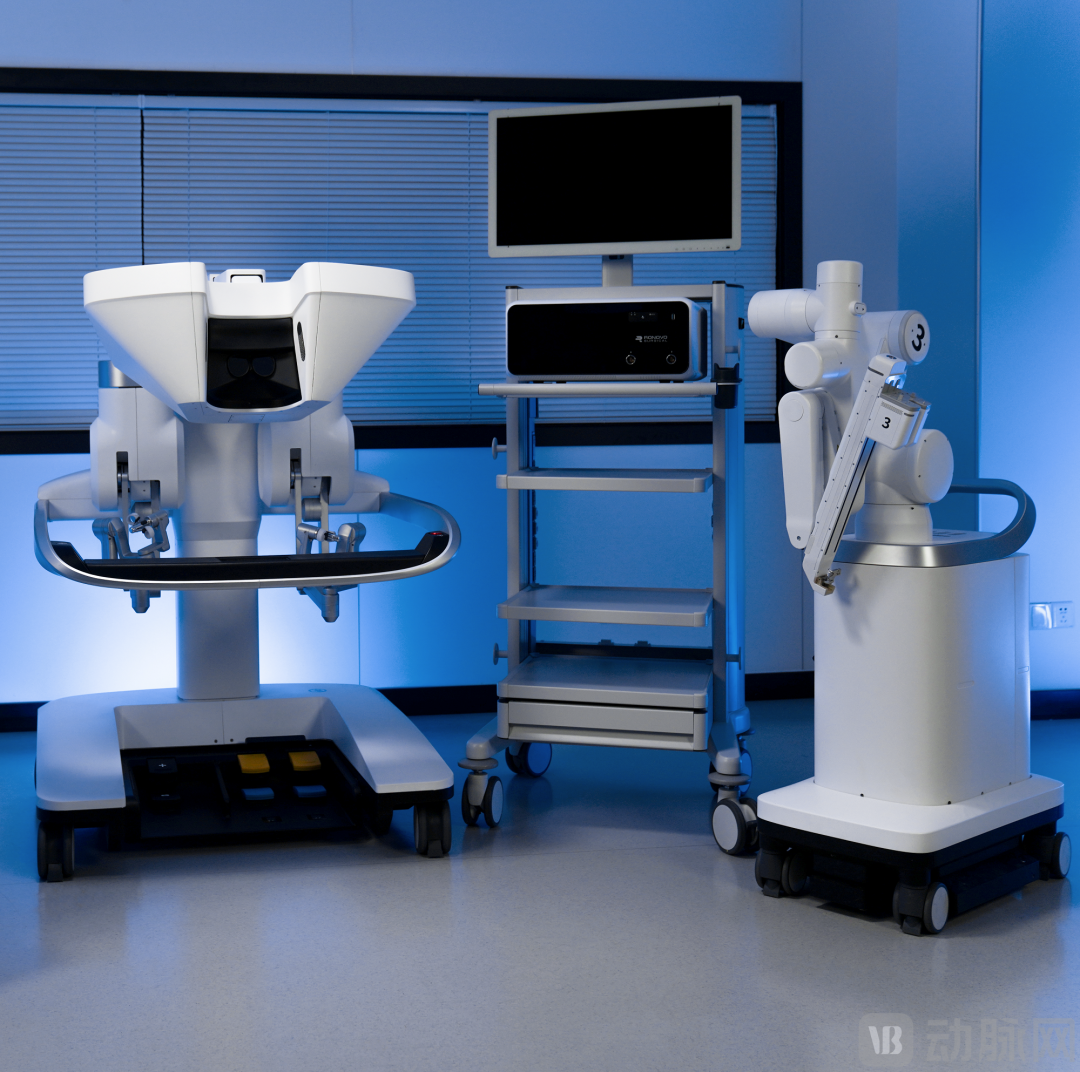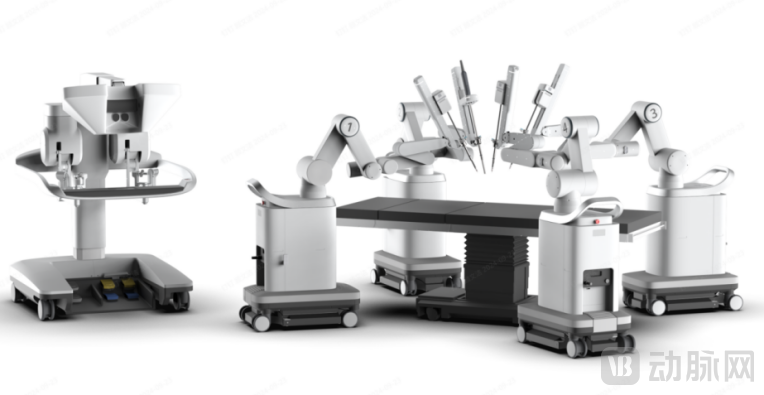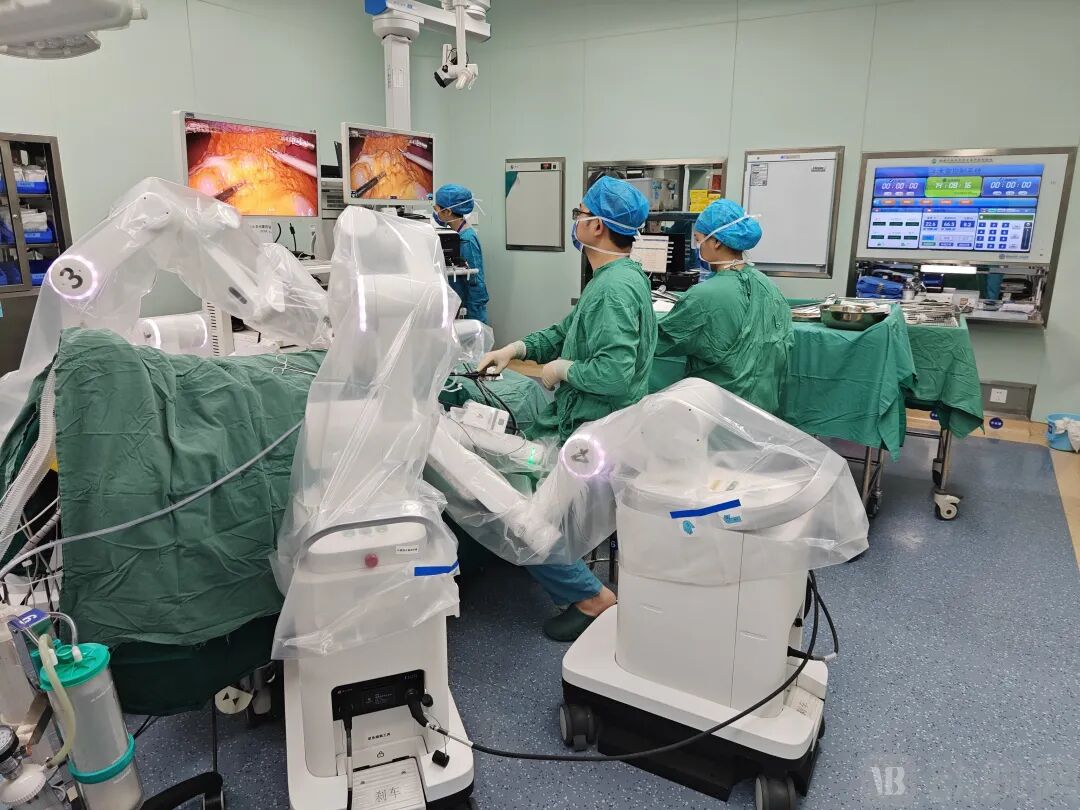
Domestic surgical robots reach a new milestone!
On March 6, 2025, Ronovo Surgical’s fully independently developed Haisan I® laparoscopic surgical robot (hereinafter referred to as “Haisan I®“) officially received the Class III medical device registration certificate from the National Medical Products Administration (NMPA) (National Medical Device Approval 20253010500).
As the first modular surgical robot in China, Haisan I® achieves a dual breakthrough of “modular architecture + full specialty adaptation”: it is the first domestic robot approved for full indications in general surgery, urology, gynecology, and thoracic surgery upon market launch. Moreover, its “modular, split, and agile” design innovates the traditional surgical robot form—separating the surgical arms, allowing a lightweight modular cart to be flexibly positioned according to the surgical procedure, and enabling easy movement between different operating rooms, breaking through spatial limitations and lowering the clinical usage threshold.
In addition, the modular innovation of Haisan I® reconstructs the allocation model of medical resources, pioneering a “customizable configuration” model in the field of surgical robots. Hospitals can flexibly select the number and type of carts based on actual needs, and can quickly deploy without the need for site renovations. Relying on its full indication coverage capability and intelligent design, it promotes the transition of robotic minimally invasive surgery from “high-end equipment concentrated in a few hospitals” to “widespread application of robotic surgery in hospitals at all levels,” truly realizing the universal implementation of advanced technology.

Haisan I® laparoscopic surgical robot
01
Split design reconstructs the surgical scene,providing a new choice of “customizable configuration” for clinical use
The Chinese surgical robot market is undergoing structural transformation, with the rise of domestic innovation accelerating the break of foreign technology monopolies. Currently, mainstream laparoscopic surgical robots mostly adopt an integrated design, facing two major issues: first, disrupting operational habits; integrated surgical robots change the traditional laparoscopic surgical operation habits due to the use of a new port placement method and wrist-rotating instruments, making it difficult to carry over the surgical experience of laparoscopic surgeons, resulting in a steep learning curve for doctors; second, spatial efficiency constraints; the fixed, large body occupies the entire operating room, leading to an average annual utilization rate of less than one for a single operating room. The high cost of operating room renovations, and the renovation work will more or less affect the normal operation of the original operating room, contradicting the hospital’s demands for cost control and efficiency improvement.

Based on the demand for millions of minimally invasive surgeries in China and the clinical pain points of tens of thousands of laparoscopic surgeons, Haisan I® reconstructs the surgical ecosystem with a modular split architecture. It deconstructs the entire machine into independently movable compact cart units, with slender arms capable of covering a wider surgical area, ensuring smooth and precise operations. Small and medium-sized operating rooms can also be easily deployed.
The split cart design not only allows flexible deployment next to the operating table, opening up space above the patient for the operator, providing ample operational space, but also easily adapts to diverse port placement needs, while meeting the surgical habits of both robotic experienced surgeons and laparoscopic experienced surgeons, thus reducing the learning curve. Additionally, the number of carts can be adjusted according to surgical needs, meeting operational requirements; at the same time, it can be flexibly arranged according to the surgical progress, turning over to the next surgery, improving the efficiency of consecutive surgeries, and achieving shared use across multiple departments and operating rooms, thereby enhancing equipment utilization.
Compared to the complex installation and debugging process of integrated robotic arms, the operation of the split cart is much simpler, with preparation and withdrawal taking only a few minutes. This “deconstruction without loss of efficiency” design truly realizes the localized innovation goal of “no need for space expansion, adaptable to existing operating rooms.”
Compared to traditional laparoscopic robots, Haisan I® achieves a dual breakthrough in optimizing usage efficiency and expanding coverage of surgical procedures through its modular split architecture, allowing doctors to flexibly configure cart positions based on surgical needs, and hospitals can purchase the number of carts according to budget gradients. The immersive doctor control console design, with a highly integrated three-dimensional visual system, provides doctors with a deeply immersive surgical view, effectively eliminating external distractions, allowing the lead surgeon to focus more on the surgical area. Especially for doctors already familiar with traditional laparoscopic surgery, it allows for a quick transition to robotic operation.
02
Full specialty coverage with significant advantages in gynecology and general surgery
Haisan I® drives innovation through clinical demand, abandoning the path of simply replicating imported equipment. With core advantages such as modular design and full indication coverage, it is expected to break through the limitations of traditional imported products in multi-specialty expansion, successfully completing multi-center clinical trials in general surgery, thoracic surgery, gynecology, and urology with a 100% success rate, becoming the first surgical robot in China to simultaneously obtain full indication certification in four major specialties.
Especially in a series of complex surgeries such as low anterior resection, iliac lymph node dissection, and lobectomy, Haisan I® fully demonstrates its unique advantages, enhancing the coverage capability and clinical value of complex procedures, gaining widespread recognition from domestic and international experts.

The general surgery team led by Li Taiyuan at the First Affiliated Hospital of Nanchang University successfully completed surgeries using Haisan I®
Dr. Mao Ying, co-founder of Ronovo Surgical, explained that traditional single-column surgical robots have limitations in activity range due to all surgical arms being concentrated on a single column, making it difficult to meet the needs of large-scale surgeries. In contrast, the split robot distributes the surgical arms around the operating table, breaking the spatial limitations of single-column designs, expanding the operational range of the robotic arms, which is particularly suitable for specialties such as general surgery and gynecology that require large operational spaces.
Professor Ji Mei from the Gynecological Minimally Invasive Center at the First Affiliated Hospital of Zhengzhou University, after completing a series of challenging gynecological surgeries using Haisan I®, commented: “These complex surgeries are the best indications for surgical robots. High-difficulty malignant tumor surgeries, minimally invasive surgeries for benign tumors in special locations, and cases with severe obesity are all very suitable for robotic surgery. Haisan I® provides a clear view and precise control, making difficult surgeries easier to perform.”[1]
Professor Gustavo Soares, an authority from the Brazilian Hernia Society, also praised Haisan I® after completing bilateral inguinal hernia repair and upper abdominal wall hernia repair surgeries, stating: “Haisan I® has the potential to complete bilateral inguinal hernia repair and upper abdominal wall hernia repair surgeries simultaneously without changing port placement and cart positioning.”[2]
At the same time, based on the new modular design, Ronovo Surgical is actively exploring more potential applications of Haisan I® in clinical settings.
It is worth mentioning that in December 2024, the launch of the “Expert Consensus on Clinical Application of Split Laparoscopic Surgical Robots in Thoracic Surgery” marks the authoritative recognition of the clinical value of Haisan I®. This consensus, based on the clinical practice of Haisan I®, systematically outlines the indications, operational norms, and technical advantages of split robots in thoracic surgery, providing reusable clinical pathway references for the industry and laying the foundation for the standardized promotion of domestic split laparoscopic surgical robots.
03
Improving accessibility and utilization with “flexibility + multi-procedure”solving the dilemmas of grassroots medical care and commercialization challenges
Currently, the commercialization of domestic surgical robots urgently needs to overcome three core challenges: first, insufficient adaptability across multiple specialties, hindering large-scale application; second, high equipment and maintenance costs, placing heavy pressure on hospitals; third, the lack of universal insurance coverage, further exacerbating the payment burden. These three barriers collectively restrict the market penetration of surgical robots, making it difficult for minimally invasive surgical technology to benefit grassroots medical care.
“We hope to bring surgical robots to secondary hospitals, county-level public hospitals, and private medical institutions, breaking the situation where high-end equipment only serves a few patients,” shared Dr. Ma Changzheng, founder of Ronovo Surgical. Grassroots hospitals typically focus on general surgery, gynecology, and other medium to low-difficulty surgeries, and do not pursue complex procedures. The demand for surgical robots in hospitals is concentrated on high utilization and low-cost operations.
With the advantages of “flexibility + multi-procedure,” Haisan I® is expected to solve the difficulties of surgical robots penetrating grassroots and commercialization challenges. First, at the conceptual level, Ronovo Surgical adheres to the principle that “innovation does not have to start from imitation,” promoting large-scale applications across multiple specialties centered on clinical needs, enhancing product cost-effectiveness and lowering the learning curve for doctors, effectively reducing the procurement and usage thresholds for grassroots medical institutions.
Secondly, at the product level, the split architecture of Haisan I® supports hospitals in flexibly purchasing carts and accessories as needed, with a lightweight body (<200kg) adaptable to older operating rooms without the need for site renovations. The modular cart can also be flexibly moved between different departments according to surgical needs, supporting multiple surgeries to be conducted consecutively, significantly improving equipment utilization. In addition, Haisan I® is compatible with traditional laparoscopic instruments, reducing reliance on specialized consumables, allowing grassroots medical institutions to introduce advanced technology at a lower cost, making it not only “affordable” but also “usable.”
With the combination of “flexibility + multi-procedure,” Ronovo Surgical has not only broken the “impossible triangle” of clinical capability, accessibility, and affordability but has also achieved the universal coverage of minimally invasive surgery from high-end tertiary hospitals to grassroots county-level facilities, providing innovative ideas for the large-scale popularization of domestic surgical robots.
On the international market front, Ronovo Surgical approached the development of Haisan I® with a global perspective, conducting systematic research on overseas disease spectra, surgical needs, payment methods, and the foundation for minimally invasive surgery, optimizing product design based on clinical feedback from domestic and international experts to ensure product adaptability to clinical scenarios in various regions worldwide. Although it has just received NMPA certification in China, its modular architecture and full indication capability already possess international competitiveness. It is reported that Ronovo Surgical has initiated overseas market access and is simultaneously promoting clinical cooperation and commercialization pilots, gradually building a global promotion network covering emerging markets and developed countries.
04
Innovation does not have to start from imitation,from technological breakthroughs to the innovative paradigm of clinical accessibility
For a long time, the high-end medical device market in China has been dominated by foreign brands. From the very beginning, Ronovo Surgical recognized that “domestic substitution ≠ simple replication.” Although imitation may be technically easier to achieve, it will encounter many difficulties in future commercialization and clinical promotion. Adhering to the concept that “innovation does not have to start from imitation,” Ronovo Surgical insists on taking the original path of solving practical clinical needs, committed to developing digital and intelligent minimally invasive surgical technologies to empower surgeons with precision and efficiency, benefiting a wide range of patients with excellent outcomes.
Ronovo Surgical has completed the development of the Haisan I® from concept design to multi-center multi-specialty clinical trials in four years, and has now formed a series of products including the Haisan I® laparoscopic surgical robot system, Haisan I® laparoscopic imaging system, Haisan I® surgical instruments, and over 150 domestic and international patent applications.
Professor Ye Dingwei, vice president of Fudan University Affiliated Tumor Hospital, mentioned, “Haisan I® is a surgical robot with independent intellectual property rights, and I believe it will definitely attract attention in the international market in the future. It will have recognition, identification, and acceptance internationally.”
The approval of the Haisan I® laparoscopic surgical robot not only marks the birth of China’s first split laparoscopic surgical robot but also showcases significant breakthroughs in technology accumulation and innovation by domestic enterprises. Perhaps in the future, when looking back at the history of high-end medical equipment in China, the approval of Haisan I® will not only be a date on a registration certificate but will also signify a cognitive leap in China’s medical innovation from “following and solving problems” to “independently proposing problems.” When more enterprises begin to innovate based on clinical pain points, the technological shackles that once constrained Chinese doctors will ultimately transform into Chinese solutions that safeguard lives.
At that moment, in the operating room, every arc traced by the surgical arm of Haisan I® is rewriting history: there is no mere imitation of “import substitution,” only the trajectory of Chinese intelligence breaking out of its cocoon; there is no pursuit of simple parameter superiority, but rather a reconstruction of value standards through clinical effectiveness—after all, on the operating table concerning life, true innovation always ends with the patient.
* References:
[1] “The Effectiveness of Medical-Engineering Cooperation is Beginning to Show, Haisan I® Successfully Completes Three Consecutive Difficult Gynecological Surgeries”
[2] “International Experts Praise! Ronovo Surgical’s Haisan I® Laparoscopic Surgical Robot Assists in Complex Hernia Repairs, Precision Without Boundaries!”


If you want to connect with the projects mentioned in the article, or if your project wants to be reported by Artery Network, or to publish financing news, please contact us; you can also join the Artery Network industry community to meet more like-minded friends.


Recent
Recommendations
Recommendations


 The content published by Artery Network is exclusively owned or held by Artery Network and related rights holders. Without permission, any reproduction, excerpting, copying, or establishing mirrors is prohibited.Artery Network, the future medical service platform
The content published by Artery Network is exclusively owned or held by Artery Network and related rights holders. Without permission, any reproduction, excerpting, copying, or establishing mirrors is prohibited.Artery Network, the future medical service platform